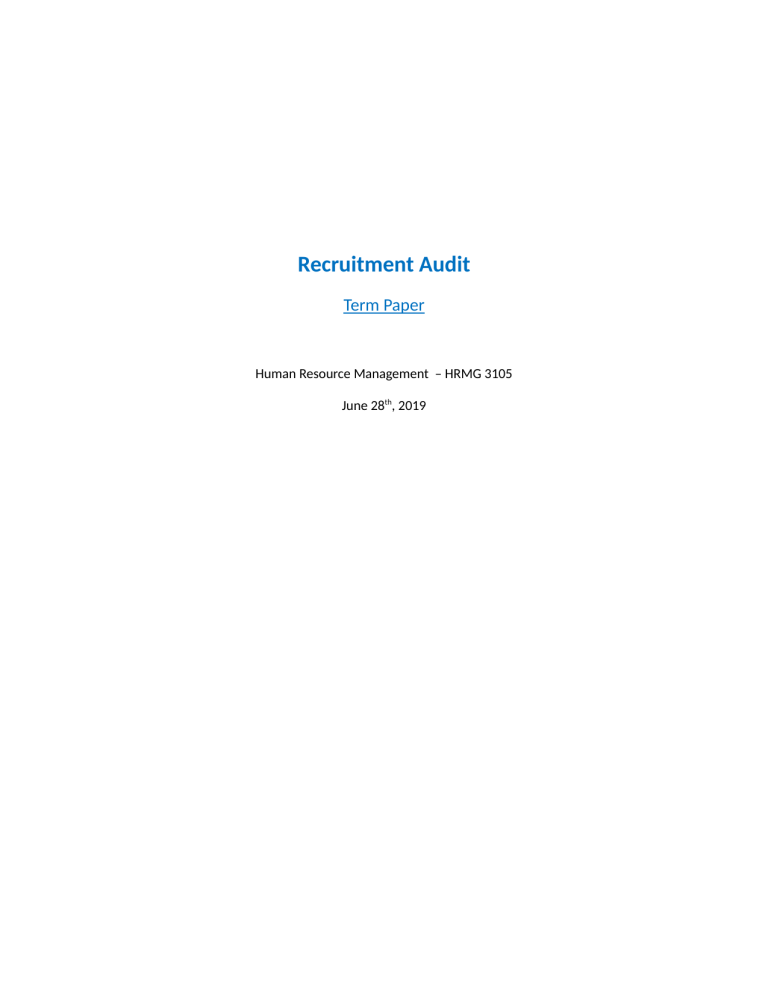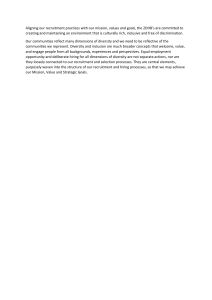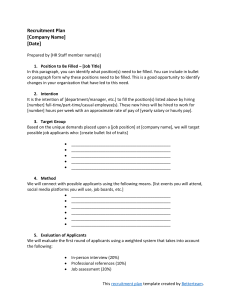
Recruitment Audit Term Paper Human Resource Management – HRMG 3105 June 28th, 2019 Mercer Celgar Zellstoff Celgar mill (ZCL) is situated near Castlegar in British Columbia, Canada, approximately 600 kilometers east of the port city of Vancouver, and produces approximately 520,000 ADMTs annually. It is one of the largest and most modern single line kraft pulp mills in North America. The mill is well-situated with respect to fiber supply and the growing Asian and North American markets. Celgar is a modern, efficient ISO 9001 certified NBSK pulp mill. In 1993, a C$850 million rebuild and modernization transformed Celgar into a high-quality, continuous process pulp mill with modern power generation and environmental treatment facilities. The completion of "Project Blue Goose" at Celgar was a highlight for Mercer in 2007 - a milestone in Mercer's North American expansion. A diverse but integrated capital project, this C$28 million project was designed to achieve operation efficiencies, increase production and improve environmental stewardship, including reduced consumption of energy and chemicals. Upon completion of the project in 2007, Celgar also became a net exporter of electricity with the potential to fulfill a growing demand for “green” energy. As part of our continued focus on energy production and sales and to increase the mill’s production of “green” energy and optimize its power generation capacity, in 2010 Celgar completed its Green Energy Project. In connection with the Green Energy Project, Celgar finalized a 10-year Electricity Purchase Agreement with BC Hydro, a local utility, under which it will sell electrical energy at “green’ rates. In October 2009, as part of their Green Transformation Program, the Canadian government, through Natural Resources Canada, agreed to provide approximately $57.7 million of funding to Celgar for projects designed to meet certain energy efficiency or environmental improvement requirements. The Green Energy Project will benefit from $46.8 million of this funding and the balance used for the funding of other eligible high return projects. Audit Function The audit function I have chosen is recruitment and onboarding. Despite the fact that onboarding occurs after the hiring process, it is still a big part of recruitment. The first impressions we take away from the interview process are just as important as the first impressions we make on the new hires. This stresses the importance of having a strong employer brand and giving your applicants a good candidate experience. In order to get the best candidates, we have to have a fully optimized recruitment process. A recruitment audit is a crucial part of recruitment. You want to know whether your recruitment efforts actually give you the desired results. Without doing a proper recruitment audit we won’t know, for example, whether our advertisements or website actually works or not. Are these things bringing us applicants? Are we spending too much time on a specific step within the process causing applicants to drop off or be missed? All of these things can be prevented if we audit our recruitment processes properly and frequently. A document on the recruitment and selection hiring process highlights the following steps: (www.hr.ucr.edu.com) Step 1: Identify Vacancy and Evaluate Need - Recruitments provide opportunities to departments to align staff skill sets to initiatives and goals, and for departmental and individual growth. Proper planning and evaluation of the need will lead to hiring the right person for the role and team. Step 2: Develop Position Description - A position description is the core of a successful recruitment process. It is used to develop interview questions, interview evaluations and reference check questions. Step 3: Develop Recruitment Plan - Each position requires a documented Recruitment Plan which is approved by the organizational unit. A carefully structured recruitment plan maps out the strategy for attracting and hiring the best qualified candidate and helps to ensure an applicant pool which includes women and underrepresented groups including veterans and individuals with disabilities. Step 4: Select Search Committee - To ensure applicants selected for interview and final consideration are evaluated by more than one individual to minimize the potential for personal bias, a selection committee is formed. The hiring manager will identify members who will have direct and indirect interaction with the applicant in the course of their job. Each hiring manager should make an effort to appoint a search committee that represents a diverse cross section of the staff. A member of the committee will be appointed as the Affirmative Action and Compliance Liaison who will monitor the affirmative action aspects of the search committee. Under-represented groups and women are to have equal opportunity to serve on search committees and special efforts should be made to encourage participation. Departments that lack diversity in their own staff should consider appointing staff outside the department to search committees or develop other alternatives to broaden the perspective of the committee. Step 5: Post Position and Implement Recruitment Plan - Once the position description has been completed, the position can then be posted to the UCR career site via the ATS. Every effort should be made to ensure the accuracy of the job description and posting text. It may not be possible to change elements of a position once posted, because it may impact the applicant pool. Step 6: Review Applicants and Develop Short List - It is recommended that all search committee members review all Applicants to ensure more than one person assesses their qualifications and that individual opinion or biases are avoided. It is permissible to have at least two committee members review all Applicants for certain recruitments in which there are extensive applicant pools to best narrow down the pool. Step 7: Conduct Interviews - The interview is the single most important step in the selection process. It is the opportunity for the employer and prospective employee to learn more about each other and validate information provided by both. By following these interviewing guidelines, you will ensure you have conducted a thorough interview process and have all necessary data to properly evaluate skills and abilities. Step 8: Select Hire- Once the interviews have been completed, the committee will meet to discuss the interviewees. Committee members will need to assess the extent to which each one met their selection criteria. Step 9: Finalize Recruitment - Upon completion of the recruitment process the offer to the selected finalist is made. I would add a final step to this process which would be Onboarding and Training. You can’t set your new hire up for success without the proper tools and knowledge about the job. Critical Issues Critical issues related to recruitment include Human Rights Legislation as well as Employment (labour) Standards Legislation. “The Canadian Human Rights Act prohibits discrimination on the basis of gender, race, ethnicity and other backgrounds. Also, Canada's Employment Equity Act and the Federal Contractors Program require employers to take active measures to improve the employment opportunities for specific groups of people in our country.” (www.canada.ca) The forces that can impact recruitment and onboarding are: Internal o HR Policies – the planning and design of the recruitment process. o Size and age of the Organization – smaller organizations are easier to manage as less manpower is required, but the larger the growth, the bigger the demand on HR and recruiting. o Budget – can the company afford large scale recruitment? o Reputation – with a good community or global reputation you end up generating a large talent pool to hire from. A newer company may experience more difficulty recruiting with no reputation due to the age of the company. External o Unemployment rate – this can cause positive or negative effects on a business. A high rate creates more applicants, and a low rate can create competition. o Competition – recruits can end up with many choices and may find it hard to attract the skills they need. o Labour laws and legislation regarding discrimination and employment conditions o Demand for specific skill sets. A shortage of skilled professionals can cause the company to suffer. Recruiting Policy at Mercer Celgar “The Company intends to recruit the best available person for all vacancies, maintaining due regard for current human rights legislation, and will make every effort to ensure that employees are selected on a fair and consistent basis. To this end, the Company will utilize a selection process with consideration given to: qualifications, experience and job related attitude/ability. These qualities will be assessed in a consistent manner including: resume, interviews, references, testing and evaluations. Recruiting is the responsibility of the Human Resources Department with final selection made by the selection committee.” Areas of weakness Our main area of weakness is what we deem our selection committee. We do not rule ourselves as we should, and bias and personal or departmental gain often get in the way of picking the best candidates. Strengths within the function The strengths of our recruitment process come from the rules that were created through our union and our management system. Even though these rules are not carried out by the positions intended, I believe they create a strong base to follow during the recruitment process for the union employees. The practice we hire by is as follows: RULES AND PROCEDURES - The following detailed work of recruiting is performed or arranged by the Human Resources Department: a. Position Review – Job Description, Rate of Pay, etc. b. Advertising c. Contacting Sources of Supply d. Interviewing e. Testing f. Reference Checking g. Arranging Medical Examinations. h. Occasionally a professional recruiting firm is employed to assist with a specific recruiting project. EMPLOYEE SELECTION PROCESS - Review current applications on file. 1. All applications received for the vacancy, whether submitted or solicited, are to be forwarded to the H.R. office. 2. Selection pre-screening is done by the Human Resources Department. Inappropriate applicants will be rejected and qualified applicants will be forwarded to the Selection Committee. Generally, the Selection Committee is composed of representatives from the department with the vacancies and an Human Resources representative. 3. The Selection Committee will agree to a short list of applicants. In most cases this will not exceed 5. 4. The Human Resources Department will arrange for interviews of the applicants by the Selection Committee. 5. The Human Resources Department will verify the records of all applicants. This includes verifying qualifications and experience as well as conducting reference checks. Inappropriate applicants are rejected. 6. The Human Resources Department, in conjunction with the interview, will conduct appropriate testing of all applicants. The tests conducted will depend on the position that is being filled and the accepted tests are forwarded to the Selection Committee. Those applicants not meeting acceptable standards are rejected. 7. With all the available information, the Selection Committee will make its final selection and recommend the successful candidate to the Department Manager. 8. Successful applicants are requested to provide confidential medical information. 9. The Human Resources Office will confirm details of the position and develop an offer for the successful applicant. The applicant will be contacted and verbally offered the position and, if accepted, the details of the offer will be confirmed in a letter. 10. Under no circumstances may anyone offer a prospective employee any special terms of employment or special conditions relating to vacations, remuneration, etc. without prior approval from the Director, Human Resources, in consultation with the Managing Director. My recommendations to improve the function My first recommendation to improve the recruitment function is to appoint a dedicated committee of recruitment personnel. We need to map out what we want our recruitment process to look like, and how we want to achieve it. We need to know most importantly, how long we want the process to take. If we are too swift, we may make crucial errors that could affect the company or employees future, or if we pause, and take too much time we jeopardize loosing quality candidates. This map can allow us to be able to see how our internal processes connect to different points in the candidate’s journey. Creating an extensive job description can also give us a better look into what we want and need from each candidate for each specific job. With detailed job descriptions we may be hiring for one position, and find qualities in a candidate that perfectly fit an entirely different job. We also would benefit from involving our current recruiters to better identify the current steps in the process, but also to identify potential errors or steps that could be avoided or added. I would want to start by involving a few recruiters at a time, but not the entire team. Once I had a solid overview of the process as it currently operates, I would have a meeting with the entire team to discuss every step in the process in more detail, and help to work out any kinks. You would want to get insight into every single step and what tasks the recruiters perform in each stage of the process. My last recommendation would be to seek external help. These are complex issues that can be difficult to take on alone, and with an outside source there would be less chance of favoritism or conflict of interest. Getting external help with an HR plan can help to clarify and streamline our vision, and identify the strategies that work best for our company, and hold us accountable to our own objectives. Summary/Conclusion The processes of human resource planning, recruitment and selection are very important as they determine the performance of an organization. They should be handled carefully to allow for their success and that of the organization as a whole. The processes are dependent on each other and success in one leads to success of the other. Works Cited: Government of Canada. Rights in the workplace. https://www.canada.ca/en/canadianheritage/services/rights-workplace.html Human Resources. Recruitment & Selection Hiring Process. https://hr.ucr.edu/recruitment/guidelines/process.html#top


